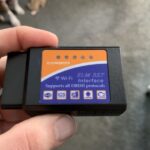The dreaded check engine light has illuminated on your dashboard, and your OBDII scanner reveals the error code P0150. This code indicates a problem with the oxygen (O2) sensor circuit, specifically Bank 2 Sensor 1. Understanding this code and its potential causes can save you time and money on repairs. This article provides a comprehensive guide to the P0150 error code, outlining its meaning, symptoms, causes, and possible solutions.
Decoding the P0150 Code: What Does It Mean?
The P0150 diagnostic trouble code signifies a malfunction in the oxygen sensor circuit for Bank 2 Sensor 1. In simpler terms, the engine control module (ECM) isn’t receiving the correct signal from this particular oxygen sensor. But what does that mean for your vehicle?
Your vehicle’s engine relies on a precise mixture of air and fuel for optimal combustion. Oxygen sensors play a critical role in this process by measuring the amount of oxygen in the exhaust gases. This data is then sent to the ECM, which adjusts the fuel injection accordingly to maintain the ideal air-fuel ratio.
“Bank 2” refers to the side of the engine opposite the cylinder number one. “Sensor 1” indicates the upstream oxygen sensor, located before the catalytic converter. This sensor measures the oxygen content in the exhaust gases leaving the engine cylinders. A faulty signal from this sensor can disrupt the engine’s performance and efficiency.
Recognizing the Symptoms of a P0150 Code
While the illuminated check engine light is the most obvious sign, a P0150 code can also manifest in various other ways:
- Rough engine idling: The engine may run unevenly or vibrate excessively while idling.
- Engine misfires: The engine may hesitate or stumble during acceleration.
- Black smoke from exhaust: Excessive fuel consumption can lead to black smoke emanating from the tailpipe.
- Reduced fuel economy: A malfunctioning oxygen sensor can cause the engine to burn more fuel than necessary.
- Engine stalling: In severe cases, the engine may stall unexpectedly.
Pinpointing the Causes of a P0150 Code
A faulty oxygen sensor is the most common culprit behind a P0150 code. However, several other factors can contribute to this issue:
- Damaged wiring: Frayed, burnt, or corroded wiring in the sensor circuit can disrupt the signal transmission.
- Loose or corroded connector: A poor connection between the sensor and the wiring harness can prevent proper signal flow.
- Exhaust leaks: Leaks in the exhaust system before the sensor can introduce unmetered oxygen, leading to inaccurate readings.
- Vacuum leaks: Leaks in the engine’s vacuum system can affect the air-fuel mixture and sensor readings.
- Faulty ECM: In rare cases, a malfunctioning ECM can misinterpret the sensor data or fail to send the correct signals.
Exploring Possible Solutions for a P0150 Code
Diagnosing and resolving a P0150 code often requires a systematic approach:
-
Inspect the wiring and connector: Visually examine the wiring harness for any signs of damage, and check the connector for looseness or corrosion. Clean or repair as needed.
-
Check for exhaust leaks: Inspect the exhaust system for any holes or cracks, particularly before the Bank 2 Sensor 1 location.
-
Test the oxygen sensor: Use a multimeter or a scan tool to check the sensor’s voltage output and response time. Compare the readings with the manufacturer’s specifications.
-
Replace the oxygen sensor: If the sensor is faulty, replace it with a new one that meets the vehicle’s specifications.
Conclusion
The EOBD/OBDII error code P0150 indicates a problem with the oxygen sensor circuit on Bank 2 Sensor 1. Addressing this issue promptly is crucial to ensure optimal engine performance, fuel efficiency, and emissions control. By understanding the code’s meaning, symptoms, causes, and potential solutions, you can effectively diagnose and resolve the problem, restoring your vehicle to its proper running condition.

